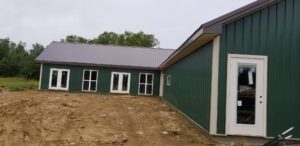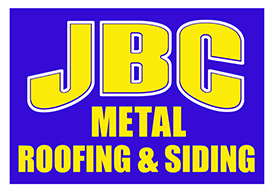Meet the Modern Era of Metal Roofs
The world of industry and agriculture demands durable, efficient, and cost-effective solutions for infrastructure. One crucial aspect of these sectors that is often overlooked is the roofing material used in buildings and structures. Metal roofs have emerged as a popular choice for industrial and agricultural work due to their exceptional durability, longevity, and cost-effectiveness.
Gone are the days when metal roofs were limited to warehouses and barns. Today, metal roofs have become a sophisticated choice for modern industrial and agricultural facilities, ranging from factories, processing plants, storage facilities, and agricultural structures like barns, stables, and poultry houses. In this blog post, we will delve into the industrial need for metal roofs and explore the return on investment (ROI) and cost-effectiveness of metal roofs in these sectors.

The Industrial Need for Metal Roofs in 2023 and beyond!
The industrial and agricultural sectors require robust and reliable roofing solutions that can withstand the harsh environments and rigorous demands of modern operations. Metal roofs have become the go-to choice for many industrial and agricultural facilities due to their unique properties that cater to the needs of these sectors.
Durability: Metal roofs are known for their exceptional durability. They are resistant to extreme weather conditions such as heavy rain, snow, hail, and high winds, making them ideal for industrial and agricultural facilities that are often exposed to the elements. Metal roofs are also fire-resistant, providing an added layer of protection to the facility and its contents.
Longevity: Metal roofs are built to last. With proper installation and maintenance, metal roofs can have a lifespan of 40 to 70 years or more, depending on the type of metal used. This longevity makes metal roofs a cost-effective choice in the long run, as they require minimal repairs and replacements compared to other roofing materials.
Strength: Metal roofs are engineered to be strong and can withstand heavy loads, making them suitable for industrial and agricultural facilities that require large spans and heavy equipment. Metal roofs can also be customized to meet specific load requirements, ensuring that the structure remains safe and secure.
Energy Efficiency: Metal roofs are known for their energy-efficient properties. They reflect sunlight, reducing heat absorption and lowering cooling costs in hot climates. Additionally, metal roofs can be coated with reflective coatings that further enhance their energy efficiency. This makes metal roofs an environmentally friendly and cost-effective choice for industrial and agricultural facilities.
Versatility: Metal roofs offer a wide range of design options, allowing for customization to suit the unique needs of industrial and agricultural facilities. They can be fabricated in various shapes, sizes, and colors to match the aesthetic and functional requirements of the facility. Metal roofs can also be installed on different types of structures, including sloped roofs, flat roofs, and curved roofs, making them versatile for various applications.
The ROI of Metal Roofs for Industrial and Agricultural Work
Investing in a metal roof for industrial and agricultural facilities can yield significant return on investment (ROI) over the long term. While the upfront costs of metal roofs may be higher compared to other roofing materials, their durability, longevity, and energy efficiency make them a cost-effective choice that can result in substantial savings over time.
Long-Term Cost Savings: One of the primary advantages of metal roofs is their long lifespan, which significantly reduces the need for frequent repairs and replacements. Metal roofs require minimal maintenance, and any repairs can be easily addressed due to their modular design. This can result in substantial cost savings on maintenance and replacement costs compared to other roofing materials that may require frequent repairs and replacements, leading to higher overall costs over time. The initial investment in a metal roof may be higher, but the long-term cost savings can far outweigh the upfront costs, resulting in a higher ROI.
Energy Efficiency: Metal roofs can contribute to significant energy savings in industrial and agricultural facilities. Their reflective properties and ability to be coated with reflective coatings help to reduce heat absorption, which can lower cooling costs in hot climates. This can result in substantial energy savings and reduced utility bills over time, contributing to a positive ROI for metal roofs.
Insurance Savings: Metal roofs are often recognized by insurance companies as a durable and fire-resistant option, which can result in lower insurance premiums for industrial and agricultural facilities. Metal roofs are less prone to damage from fire, hail, and extreme weather events, reducing the risk of insurance claims. This can lead to lower insurance costs over the lifespan of the metal roof, further enhancing the ROI.
Increased Property Value: Installing a metal roof can also increase the overall value of the industrial or agricultural property. Metal roofs are considered a premium roofing option due to their durability, longevity, and energy-efficient properties. Potential buyers or investors may be willing to pay a premium for a property with a metal roof, resulting in a higher return on investment when selling or leasing the property.
Metal Roofs as a Cost-Effective Solution for Industrial and Agricultural Work
Metal roofs are a cost-effective solution for industrial and agricultural work, offering a combination of durability, longevity, energy efficiency, and versatility that cater to the unique needs of these sectors.
Durability and Longevity: Metal roofs are known for their exceptional durability and longevity, making them a cost-effective choice in the long run. They are resistant to extreme weather conditions, fire, and heavy loads, reducing the need for frequent repairs and replacements. This results in lower maintenance and replacement costs over time, leading to cost savings and a higher ROI.
Energy Efficiency: Metal roofs can contribute to significant energy savings in industrial and agricultural facilities. Their reflective properties and ability to be coated with reflective coatings help to reduce heat absorption, leading to lower cooling costs. This can result in substantial energy savings and reduced utility bills over time, making metal roofs a cost-effective option for the long term.
Minimal Maintenance: Metal roofs require minimal maintenance compared to other roofing materials. They are resistant to mold, rot, and pests, reducing the need for frequent inspections and treatments. Any repairs that may be needed can be easily addressed due to the modular design of metal roofs, resulting in lower maintenance costs and further enhancing their cost-effectiveness.
Versatility and Customization: Metal roofs offer a wide range of design options and can be customized to suit the unique needs of industrial and agricultural facilities. They can be fabricated in various shapes, sizes, and colors to match the aesthetic and functional requirements of the facility. Metal roofs can also be installed on different types of structures, including sloped roofs, flat roofs, and curved roofs, making them versatile for various applications. This versatility and customization options allow for cost-effective solutions that meet the specific needs of the facility.
Sustainability: Metal roofs are considered a sustainable choice for industrial and agricultural facilities. They are made from recyclable materials and can be recycled at the end of their lifespan, reducing the environmental impact. Metal roofs also contribute to energy savings due to their reflective properties, making them an environmentally friendly choice. This sustainability factor adds to the cost-effectiveness of metal roofs, as they align with the growing demand for eco-friendly solutions in the modern era.
Why you need metal roofs
Metal roofs have emerged as a cost-effective and durable solution for industrial and agricultural work. Their exceptional durability, longevity, energy efficiency, minimal maintenance requirements, versatility, and sustainability make them a preferred choice for modern facilities in these sectors. While the upfront costs of metal roofs may be higher compared to other roofing materials, the long-term cost savings in terms of reduced maintenance, energy efficiency, insurance savings, and increased property value outweigh the initial investment, resulting in a higher return on investment.
Metal roofs are well-suited for industrial and agricultural facilities due to their ability to withstand harsh weather conditions, resist fire and heavy loads, and require minimal maintenance. They also contribute to energy savings through their reflective properties and can be customized to meet the specific design requirements of a facility. Additionally, metal roofs are recognized by insurance companies as a durable and fire-resistant option, resulting in lower insurance premiums, and they can increase the overall value of a property.
The versatility of metal roofs allows for a wide range of design options and customization, making them adaptable to different types of structures and applications. They are also considered a sustainable choice, as they are made from recyclable materials and contribute to energy savings.
Metal roofs remain a cost-effective solution for industrial and agricultural work. Their durability, longevity, energy efficiency, minimal maintenance, versatility, and sustainability make them a wise investment for modern facilities in these sectors. While the initial costs may be higher, the long-term cost savings and benefits of metal roofs, such as reduced maintenance, energy savings, insurance savings, and increased property value, make them a financially viable option. As industrial and agricultural facilities continue to seek durable, sustainable, and cost-effective roofing solutions, metal roofs are likely to remain a popular choice for years to come.


Leave a Reply